Nuclear weapon is a weapon that gets its destructive power by turning matter into energy. All nuclear weapons are explosive devices. They are carried in missiles, bombs, artillery shells, mines, or torpedoes. The most powerful nuclear weapons are far more destructive than any conventional (nonnuclear) weapon. A nuclear weapon set off in a large city could kill millions of people. A large nuclear war could devastate Earth’s climate and ability to support life.

Nuclear weapons work through reactions in the nuclei (cores) of atoms. They can be divided into two groups: fission weapons and thermonuclear weapons. Fission weapons are also called atomic bombs. Thermonuclear weapons are also called hydrogen bombs or fusion weapons. Thermonuclear weapons are generally far more powerful than fission weapons.
The only nuclear weapons ever used in combat were among the first ones developed. They were two fission bombs dropped by the United States on the Japanese cities of Hiroshima and Nagasaki in 1945, during World War II (1939-1945). The bombs killed from 110,000 to 140,000 people. They also destroyed large areas of both cities. The terrible destruction became a major factor in Japan’s decision to surrender to the United States and its allies. Japan’s surrender ended the war.
Loading the player...Eyewitness account of the bombing of Nagasaki
After World War II, the United States and the Soviet Union entered a period of intense rivalry called the Cold War. But the deadly risk of nuclear war was so great that neither side actually attacked the other. To avoid the terrible damage that nuclear weapons could cause, many nations have long sought ways to control such weapons and reduce the risk of war.
Today, eight countries in the world have nuclear arsenals (weapons supplies). The United States and Russia (formerly part of the Soviet Union) have most of the world’s nuclear weapons. Other countries with nuclear arms include China, France, India, Israel, Pakistan, and the United Kingdom. North Korea has detonated several nuclear devices in test explosions. In addition, many experts believe that Iran is planning to build nuclear weapons. South Africa once possessed nuclear weapons. But the country voluntarily destroyed its arsenal in the early 1990’s. Several other nations might have the ability to build nuclear weapons. Many experts believe the greatest threat to international peace and security is the possibility that a terrorist group could acquire and use a nuclear weapon.
How nuclear weapons work
Conventional bombs get energy from chemical reactions. Such reactions involve changes in the structure of molecules (groups of atoms). But they leave the nuclei of the atoms themselves unchanged. In contrast, nuclear weapons get energy through nuclear reactions. Such reactions change the structure of atomic nuclei. In the process, matter in the nuclei is converted into energy. The result is a huge explosion.
The particles that make up an atom’s nucleus are called protons and neutrons. They have much more mass than the electrons that swirl around the nucleus. The number of protons in an atom’s nucleus determines what kind of element an atom is. For example, the lightest element, hydrogen, has one proton. Helium has two protons. Uranium has 92 protons.
Nuclear reactions involve not only specific elements but also specific isotopes of those elements. An element’s various isotopes have the same number of protons, but different numbers of neutrons.
Fission weapons
generate their destructive power through the fission (splitting) of atomic nuclei. Only three materials are known to be fissionable—that is, capable of fission—in weapons. They are two isotopes of uranium and one isotope of plutonium.
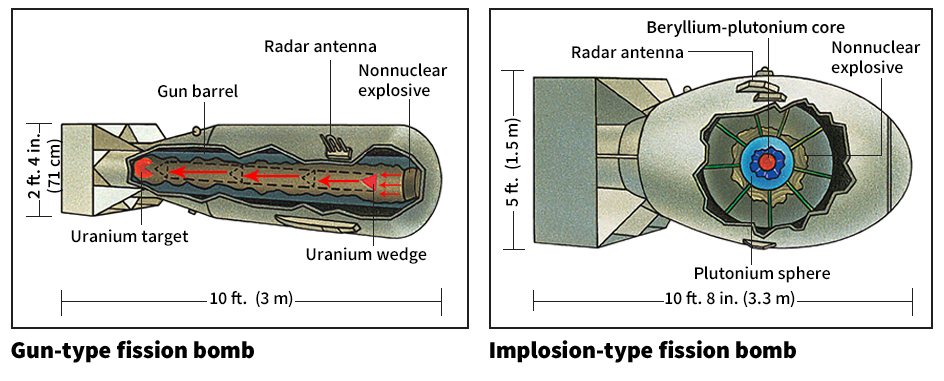
Nuclear fission occurs when a neutron strikes, and splits, the nucleus of a uranium or plutonium atom. Splitting the nucleus transforms a small amount of its matter into a large amount of energy. In addition, the fission releases two or three additional neutrons. These neutrons may then split other nuclei. If this process continues, a self-sustaining chain reaction begins. In a chain reaction, many nuclei split rapidly. Their combined energies produce a fission explosion.
To generate a self-sustaining chain reaction, a nuclear weapon must have a certain amount of fissionable material. This amount is known as the critical mass. A mass too small to support a chain reaction is called a subcritical mass.
A fission weapon uses one of two methods to create a critical mass, the gun-type method or the implosion method. In the gun-type method, two subcritical pieces of material are placed in a device similar to a gun’s barrel. One piece rests at one end of the barrel. The other is some distance from the first piece. This second piece has a powerful conventional explosive behind it. The barrel is sealed at both ends. When the weapon’s fuse is triggered, the explosive propels the second subcritical mass at high speed into the first. The resulting combined mass immediately becomes supercritical (greater than critical). This result is a rapid, self-sustaining chain reaction, and thus a nuclear explosion. The United States used a gun-type fission bomb at Hiroshima.
In the implosion method, a subcritical mass is made supercritical by compressing it into a smaller volume. The subcritical mass is in the center of the weapon. It is surrounded by conventional explosives. When the fuse is triggered, all the conventional explosives go off at the same time. The explosions squeeze the mass into a high-density supercritical mass. A self-sustaining chain reaction occurs, causing the nuclear explosion. The United States used an implosion-type fission bomb at Nagasaki.
Thermonuclear weapons
get their power from the fusion (combining) of atomic nuclei under intense heat. The nuclei are those of special isotopes of hydrogen. When the hydrogen nuclei fuse, they form a helium nucleus. The fusion also releases huge amounts of energy and extra neutrons.
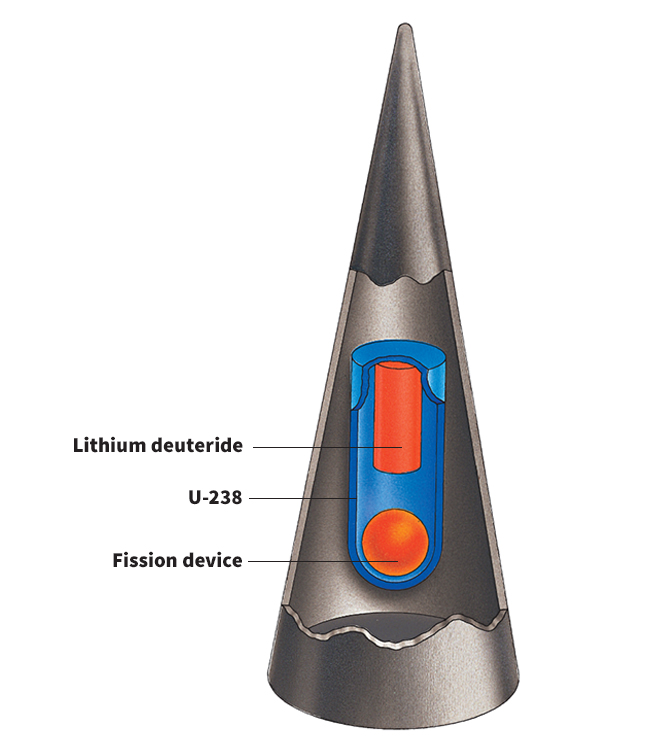
Fusion reactions require temperatures equal to, or greater than, those found in the sun’s core—about 27 million °F (15 million °C). The only practical way to achieve such temperatures on Earth is with a fission explosion. Thus, a thermonuclear weapon contains an implosion-type fission device that, in turn, triggers fusion.
When the fission device explodes, it releases neutrons. The neutrons bombard a compound inside the weapon called lithium 6 deuteride. It consists of lithium and deuterium, an isotope of hydrogen with an extra neutron. When struck with neutrons, the compound’s lithium splits into helium and another hydrogen isotope, called tritium, with two extra neutrons. Pairs of the two hydrogen isotopes—two deuteriums, two tritiums, or one of each—fuse together. A small amount of matter from each nucleus converts to a large amount of energy. Thus, a thermonuclear explosion occurs.
The yield (explosive power) of a thermonuclear weapon can be increased by blanketing the lithium 6 deuteride with a uranium isotope. The uranium fissions from the extra neutrons released during the reactions. On the other hand, a neutron bomb—also called an enhanced radiation (ER) weapon—has a low explosive yield. In a neutron bomb, most of the neutrons are allowed to escape into the air. The neutrons kill living things while causing comparatively little damage to buildings and other structures.
Types of nuclear weapons
The explosive material in a nuclear weapon must be attached to a delivery system. Such a system may be a bomb or a guided missile. Nuclear weapons can thus also be classified by their delivery systems. In addition, they can be divided into two main types, depending on the role for which they are designed. These types are strategic nuclear weapons and tactical nuclear weapons.
Strategic nuclear weapons
are designed primarily to attack targets in an enemy’s homeland from great distances. Strategic nuclear weapons generally target cities, industrial centers, and the enemy’s nuclear arsenal. These weapons can be delivered by long-range bombers or by missiles. The missiles with the longest range are called intercontinental ballistic missiles (ICBM’s). They can deliver explosive devices to targets beyond 3,400 miles (5,500 kilometers) from the launch site. Some missiles are based on land. Others are based underwater on submarines. They are called submarine-launched ballistic missiles (SLBM’s). Some strategic missiles have several nuclear devices or warheads. Each warhead carries explosive material to a separate target.
Tactical nuclear weapons
are designed for use on a military battlefield. They could be used, for example, to attack an invading enemy’s troop formations. Tactical nuclear weapons are used in military theaters (combat areas). Thus, they are sometimes called theater nuclear weapons. Tactical nuclear weapons generally have smaller yields than strategic nuclear weapons. They are also delivered from shorter ranges. They include bombs delivered by fighter aircraft, short and medium-range ballistic missiles, and jet-powered cruise missiles. They also include nuclear artillery shells, surface-to-air missiles (SAM’s), mines, and torpedoes.
Effects of nuclear weapons
Nuclear explosive devices have different yields. Most large thermonuclear weapons are about 8 to 40 times as powerful as the Hiroshima bomb. Some bombs made during the Cold War had yields of about 20 megatons, equivalent to the yield of about 1,540 Hiroshima bombs. A megaton is the amount of energy released by 1 million tons (907,000 metric tons) of TNT. Today, most nuclear devices have yields of less than 1 megaton.
The effects of a nuclear explosion can vary greatly, depending on a number of factors. These factors include the weapon’s yield, the weather, the terrain, and the altitude of the explosion. This section describes the possible effects of a 1-megaton nuclear weapon. The weapon’s explosion would produce four basic effects. They are a blast wave, thermal radiation, prompt nuclear radiation, and residual nuclear radiation.
Blast wave.
The explosion begins with the formation of a fireball. The fireball is a cloud of dust and extremely hot gases under high pressure. A fraction of a second after the explosion, the gases begin to expand. They form a blast wave, also called a shock wave. This wave is a wall of compressed air. It moves rapidly away from the fireball. The blast wave created by a 1-megaton explosion could travel about 12 miles (19 kilometers) from ground zero in just 50 seconds. Ground zero is the point on the ground directly below the explosion.
The blast wave causes most of the explosion’s damage. As the wave moves forward, it creates overpressure, atmospheric pressure above the normal level. A 1-megaton explosion can produce enough overpressure to destroy most buildings within 1 mile (1.6 kilometers) of ground zero. This overpressure can also cause moderate to severe damage within 6 miles (10 kilometers) of ground zero.
Strong winds accompany the blast wave. These winds may reach speeds of 400 miles (640 kilometers) per hour at 2 miles (3.2 kilometers) from ground zero. The blast wave and wind probably would kill most of the people within 3 miles (4.8 kilometers) of ground zero. The blast and wind probably would cause some deaths between 3 and 6 miles (4.8 and 9.7 kilometers) from ground zero. Many other people within 6 miles of ground zero would be injured.
Thermal radiation
consists of heat and light given off by the fireball. The explosion’s blinding light can cause eye injuries. Heat from the explosion creates skin burns, called flash burns. Flash burns caused from 20 to 30 percent of the deaths at Hiroshima and Nagasaki.
Thermal radiation also can ignite flammable materials, such as newspapers and dry leaves, causing large fires. Some scientists theorize that, in a major nuclear war, the smoke from such fires would absorb enough sunlight to lower Earth’s surface temperature for several months or years. The lowered temperatures would result in widespread crop failure and famine. This possible effect of nuclear war is called nuclear winter. However, the effects of thermal radiation can vary, depending on conditions at the time of the explosion. In a light atmospheric haze, for example, the effects could be only one-hundredth as strong as they would be in clear air.
Solid, nontransparent objects—such as walls, trees, and rocks—can shield people from the direct effects of thermal radiation. In addition, light-colored clothing reflects heat. It can thus help protect a person from some flash burn effects. However, thermal radiation from a 1-megaton explosion can produce second-degree burns (blistering) of exposed human skin up to 11 miles (18 kilometers) from ground zero. The thermal radiation would last only about 10 seconds. Thus it would char, but not completely burn, heavy fabrics and thick pieces of wood or plastic.
Prompt nuclear radiation
begins at the instant of the explosion. It lasts about a minute. It consists of neutrons and gamma rays. Gamma rays are a form of radiation similar to—but more powerful than—X rays. The fireball emits neutrons and some of the gamma rays almost instantaneously. The rest of the gamma rays are given off by a huge mushroom-shaped cloud of radioactive material formed by the explosion. Nuclear radiation can destroy living cells and prevent normal cell replacement. Large doses of radiation can cause death. For more information about how radiation affects the human body, see Radiation (Effects of radiation) and Radiation sickness.
Prompt radiation decreases rapidly in strength as it moves away from ground zero. Thus, people farther from ground zero would suffer less harm from prompt nuclear radiation.
Residual nuclear radiation
is given off later than one minute after the explosion. Residual radiation created by fission consists of gamma rays and electrons. Residual radiation produced by fusion is made up primarily of neutrons. The radiation strikes particles of debris swept up in the mushroom-shaped cloud during the nuclear explosion. As a result, these particles become radioactive. They fall to the ground and are known as fallout. The closer an explosion occurs to Earth’s surface, the more fallout it produces.
Early fallout
reaches the ground within 24 hours of the explosion. Its heavier particles are highly radioactive, and most fall downwind from ground zero. Early fallout kills or severely injures living things.
Delayed fallout
reaches the ground from 24 hours to a number of years after the explosion. It consists of tiny, often invisible, particles that may fall in small amounts over large areas. Such fallout causes long-term radiation damage to living things. See Fallout.
Nuclear strategy
During the Cold War, the United States and the Soviet Union were known as superpowers because of their military dominance. A policy of nuclear deterrence dominated both countries’ military planning. Both sides threatened to respond to any initial attack with a major nuclear counterattack. Such threats were intended to deter (discourage) the other side from attacking first.
Many historians believe nuclear deterrence helped keep the peace during the Cold War. However, many experts think deterrence became more complicated after the Cold War ended. In the case of nuclear-armed terrorists, for example, deterrence might not work.
Mutually assured destruction.
Stable nuclear deterrence was made possible by a situation known as mutually assured destruction (MAD). Under MAD, both the United States and the Soviet Union had the ability to launch a devastating nuclear attack, even if the opponent struck first. In the event of a nuclear war, then, both sides would be certain to suffer unacceptable damage. Thus, neither side would have a reason to start conflict.
For MAD to work, both sides needed a secure second strike capability. That is, both sides had to be able to absorb a massive nuclear attack and retain the ability to launch a devastating counterattack.
MAD would have been undermined if one side could launch a splendid first strike. This term refers to a nuclear attack that completely destroys the enemy’s nuclear arsenal. A country that could launch a splendid first strike need not fear a nuclear counterattack. It might therefore be tempted to start a nuclear war. As a result, the superpowers went to great lengths during the Cold War to make sure that their nuclear weapons could survive an attack. For example, the United States placed nuclear weapons in submarines and in hardened missile silos. It also kept nuclear-armed bomber planes continuously in the air. Such measures made it more difficult for the Soviet Union to attack U.S. nuclear weapons.
Nuclear superiority.
During the Cold War, strategists debated whether nuclear superiority contributed to nuclear deterrence. Nuclear superiority means having a larger and better arsenal of nuclear weapons than an opponent. Advocates of nuclear superiority argued that their opponent might not be deterred from launching a nuclear attack if it could inflict significantly more damage. Critics believed that a second strike capability was itself enough to deter an opponent. Nevertheless, the United States and the Soviet Union both built tens of thousands of nuclear weapons. This massive build-up is called an arms race. It was motivated by each country’s fear of its opponent achieving nuclear superiority.
Nuclear defense.
The United States and the Soviet Union also tried to build defenses against nuclear weapons. Missile defenses use missiles to target and destroy an opponent’s nuclear-armed missiles before they can reach their target. Civil defenses include underground bunkers and fallout shelters. These facilities are designed to help people survive during and after a nuclear war. Critics argued that such defenses were expensive and ineffective. They also claimed that defenses could undermine MAD. They reasoned that if one side felt protected from nuclear attack, it might not be deterred from starting a nuclear war.
Post-Cold War strategy.
Many experts believe that nuclear deterrence has become more complicated since the end of Cold War. Many more countries have nuclear weapons. Each nuclear-armed country today might have multiple nuclear-armed enemies. In addition, MAD might not hold for countries with smaller nuclear arsenals. New nuclear powers also have less experience managing nuclear weapons. Thus, they may be more likely to have a nuclear accident. Experts worry that regional nuclear powers—such as India and Pakistan—could someday fight a nuclear war.
Nuclear terrorism became a concern after the terrorist attacks of Sept. 11, 2001. Most experts believe that nuclear deterrence will not work against terrorists. Terrorists do not control entire countries. They are often well-hidden. They may even be willing to carry out a suicide attack with nuclear weapons. Such factors make it difficult—or pointless—to threaten terrorists with a second strike. Experts believe that a terrorist group with nuclear weapons would likely use them. The key to stopping nuclear terrorism is thus to prevent terrorists from acquiring nuclear weapons at all.
Controlling nuclear weapons
Because of the great dangers associated with nuclear weapons, many nations have made attempts to control their spread. The chief approaches to control have been arms control and nuclear nonproliferation.
Arms control
refers to agreements between nuclear-armed countries to limit the size and deadliness of their nuclear arsenals. Arms control agreements can contribute to stability by ensuring mutually assured destruction. The agreements also can stop expensive arms races. In addition, they can limit the amount of damage that would occur if a nuclear war broke out.
Some arms control treaties limit the size of nuclear arsenals. In 1972, for example, the United States and the Soviet Union signed the Strategic Arms Limitation Treaty (SALT I). The treaty froze the number of strategic ballistic missile launchers in both countries at their existing levels. In 2010, the United States and Russia signed the New Strategic Arms Reduction Treaty (New START). The treaty limits each side’s deployed (positioned for use) strategic warheads to 1,550.
Other arms control agreements place limits on nuclear testing. Test bans make it difficult for countries to design and build new nuclear weapons. The bans also protect people and the environment from harmful radiation produced by nuclear tests. The first major arms control treaty was the Limited Test Ban Treaty (LTBT) of 1963. The treaty banned nuclear weapons tests in the atmosphere, in outer space, and underwater. The Comprehensive Nuclear-Test-Ban Treaty (CTBT) of 1996 calls for the end of all nuclear weapons tests. To go into effect, the treaty must be ratified by all countries that have nuclear reactors (devices for producing nuclear energy). About three-fourths of those countries have ratified the treaty, including Russia. The United States has not ratified it.
Nuclear nonproliferation
refers to efforts to prevent additional countries or terrorist groups from acquiring nuclear weapons. Nonproliferation measures include international treaties, economic sanctions (penalties), military strikes, inducements (rewards), and nuclear security.
Treaties.
The Nuclear Nonproliferation Regime is a set of international agreements designed to prevent the spread of nuclear weapons. The cornerstone of the regime is the Nuclear Nonproliferation Treaty (NPT), which came into force in 1970. The NPT recognizes the United States, Russia, China, France, and the United Kingdom as nuclear weapon states. Other countries signed the treaty as nonnuclear weapon states. These countries agreed never to acquire nuclear weapons. In exchange, the nonnuclear weapon states receive a number of benefits. The benefits include assurances that their rivals will not acquire nuclear weapons. They also include help with nuclear technology for peaceful purposes. In addition, nuclear weapon states promised to negotiate to give up nuclear weapons in the future.
Nearly every country in the world is a member of the NPT. India, Israel, and Pakistan—countries that later obtained nuclear weapons—did not sign the treaty. North Korea withdrew from the treaty in 2003 after revealing that it had a program to develop nuclear weapons.
Sanctions.
Countries use economic sanctions to deter other countries from acquiring nuclear weapons. Sanctions limit trade and investment in target countries. They are designed to force a country to choose between nuclear weapons and a healthy economy. From 2006 to 2010, for example, the United Nations passed four rounds of economic sanctions against Iran. The sanctions were in response to the country’s violations of its NPT commitments.
Military strikes
have also been used to prevent countries from acquiring nuclear weapons. Such a strike may destroy the facilities used to build nuclear weapons. In this way, military attacks can stop—or at least delay—a country’s nuclear program. For example, during World War II, the United States targeted Nazi Germany’s nuclear research facilities. In 2007, Israel bombed a nuclear reactor in Syria. The reactor was thought to be part of a nuclear weapons program.
Inducements.
Countries also use inducements to encourage other countries not to develop nuclear weapons. The promises under the NPT to provide peaceful nuclear technology are one example of inducements. The United States also provides security guarantees to many of its allies. As part of these guarantees, the United States promises to retaliate if another country attacks the ally with nuclear weapons. These guarantees are sometimes called a nuclear umbrella or extended deterrence. They are designed to convince U.S. allies that they can be secure without nuclear weapons of their own.
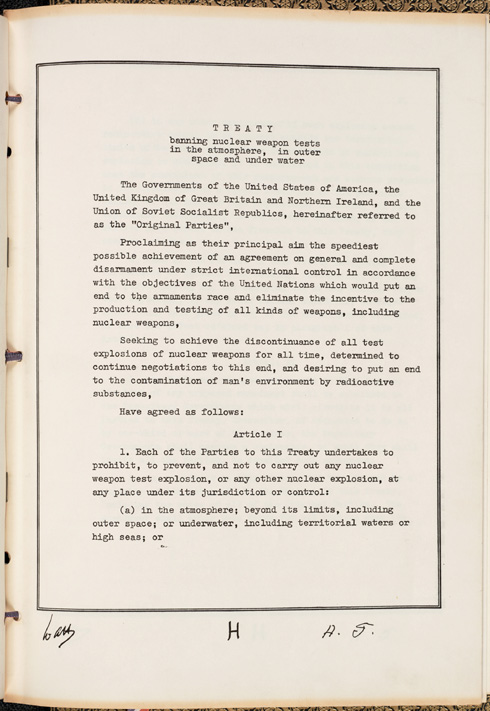
Security.
Since the terrorist attacks of Sept. 11, 2001, nuclear security has become an important part of international nonproliferation efforts. Terrorists can most easily obtain nuclear weapons or materials by stealing them from a nuclear-armed state. A number of international agreements have thus triggered steps to increase the security of state nuclear weapons materials and facilities. These agreements include United Nations Security Council Resolution 1540 and the Global Initiative to Combat Nuclear Terrorism.
History
Scientists gained an understanding of the basic structure of the atom during the late 1800’s and early 1900’s. In 1938, researchers discovered that splitting the nucleus of a uranium atom released much energy. See Atom (Development of the atomic theory); Nuclear energy (The development of nuclear energy).
World War II.
By early 1939, only months before the start of World War II, physicists in the United States had become aware of the potential military applications of nuclear energy. They were also concerned that Nazi Germany might develop a nuclear weapon. In August 1939, the German-born physicist Albert Einstein helped alert U.S. President Franklin D. Roosevelt to the potential military applications of nuclear fission. World War II began on Sept. 1, 1939. The United States entered the war in December 1941. In 1942, the U.S. government set up the Manhattan Project to design and build a fission bomb.
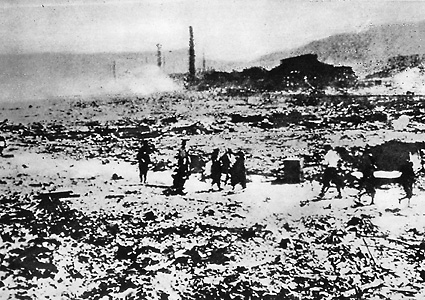
On July 16, 1945, Manhattan Project scientists led by the American physicist J. Robert Oppenheimer exploded the first experimental nuclear device. The test, at the Trinity test site near Alamogordo, New Mexico, used an implosion-type design and yielded 22 kilotons.
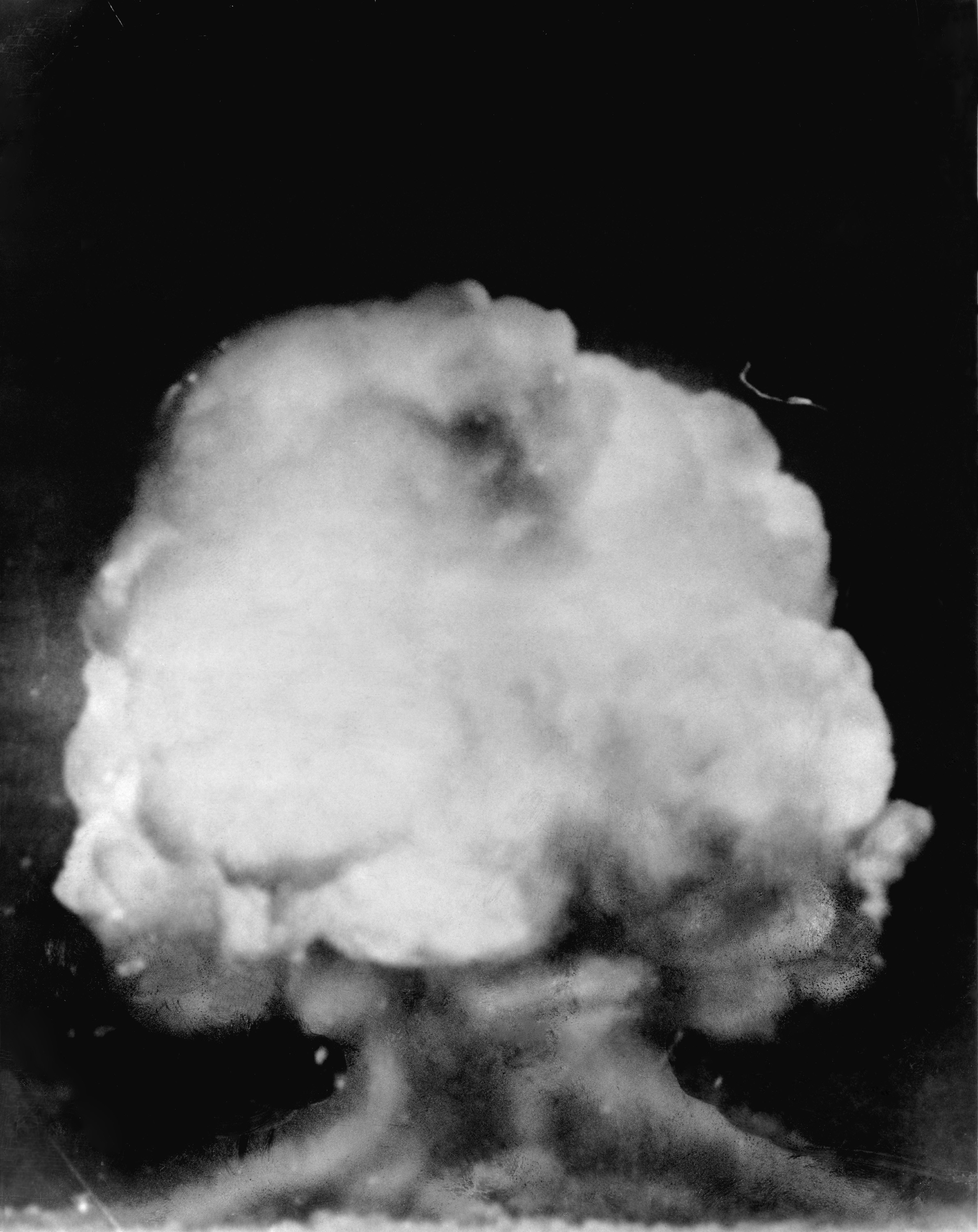
The first nuclear weapon used against Japan was a gun-type fission bomb. Its yield was about 13 kilotons. An American B-29 aircraft named the Enola Gay dropped the bomb on Hiroshima on Aug. 6, 1945. Three days later, another B-29 dropped a 22-kiloton implosion-type fission bomb on Nagasaki. These bombs largely destroyed both cities. But the number of deaths differed greatly. The smaller bomb killed from 70,000 to 100,000 people in Hiroshima, which has a flat terrain. The larger bomb killed about 40,000 in Nagasaki, which is hilly. Other people in both cities died later of injuries and radiation. On Aug. 14, 1945, Japan agreed to surrender, ending World War II.
The Cold War.
In 1949, the Soviet Union tested its first fission device in the midst of rising tension between the superpowers. In 1952, during the Korean War, the United States exploded the first experimental thermonuclear device. The Soviet Union set off its first weapons-grade thermonuclear device in 1955. In the mid-1950’s, the Soviets built the first submarines equipped with nuclear missiles. In 1957, they test-launched the first land-based intercontinental ballistic missile (ICBM). The United States developed its first ICBM’s and SLBM’s in 1959.
During the 1960’s, the United States and the Soviet Union experienced a number of crises that almost led to nuclear war. One example became known as the Cuban missile crisis. In 1962, the United States learned that the Soviet Union had installed missiles in Cuba. The United States considered invading the Soviet-allied island country. In addition, the U.S. Navy held a blockade around the island against Soviet ships. In the end, the Soviet Union removed the missiles from Cuba and nuclear war was averted (see Cuban missile crisis).
As time went on, the strategic nuclear balance stabilized. The frequency of nuclear crises between the superpowers diminished. By the 1970’s, the superpowers reached a cooling of tensions known as détente. This situation allowed for the negotiation and conclusion of a number of nuclear arms control treaties.
The superpowers were also able to cooperate on nuclear nonproliferation. They were the key actors behind the establishment of the Nuclear Nonproliferation Treaty. Both the United States and the Soviet Union were successful in preventing most of their allies from acquiring nuclear weapons. But during the Cold War, the United Kingdom (1952), France (1960), China (1964), and Israel (1967) succeeded in gaining nuclear weapons.
The end of the Cold War
in the early 1990’s reduced the political tensions between the superpowers. United States and Soviet leaders began reducing their nuclear arsenals. The threat of a nuclear war between the superpowers had diminished. As a result, many experts shifted their attention to the threat of nuclear proliferation.
After the Soviet Union broke up in 1991, the Soviet military left nuclear weapons in the newly independent countries of Belarus, Kazakhstan, and Ukraine. These countries quickly returned the weapons to Russia.
In 1998, both India and Pakistan conducted nuclear tests. Like the superpowers before them, India and Pakistan soon experienced a series of crises. These crises threatened to draw them into a nuclear war. In 1999, fighting broke out between the two countries over control of a mountainous region called Kashmir.
After the terrorist attacks of Sept. 11, 2001,
many experts assessed that nuclear terrorism posed the greatest threat to international peace and security. World leaders began focusing on countries that had nuclear programs and ties to terrorist organizations. The U.S.-led invasion of Iraq in 2003 was partially motivated by the belief that Iraq might transfer weapons of mass destruction (WMD’s)—a category that includes nuclear weapons—to terrorist groups. However, no WMD’s were found in Iraq.
The international community also put pressure on nuclear programs in Iran, Libya, and North Korea. Libya gave up its nuclear program in 2003. But North Korea conducted nuclear tests in 2006, 2009, 2013, 2016, and 2017. Iran continued to develop its nuclear capabilities. But the country claimed that such development was only for peaceful energy purposes.
